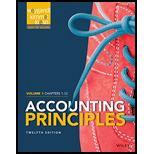
Concept explainers
(a)
(1)
Periodic Inventory System: It is a system in which the inventory is updated in the accounting records on a periodic basis such as at the end of each month, quarter or year. In other words, it is an accounting method which is used to determine the amount of inventory at the end of each accounting period.
Inventory cost flow: It refers to the flow (movement) of inventory when it is purchased or sell by the business organization.
The various inventory cost flow methods are:
- First-in, first-out (FIFO)
- Last in, first-out (LIFO)
- Average-cost
Specific identification method: In the identification method of inventory costing, business organization needs to record the each item of inventory at its actual cost.
Income Statement: The income statement is that financial statement which shows the net income (or loss) of the Company. In the income statement, to calculate the net income, all expenses incurred by the Company are deducted from the total revenue of the Company.
To determine: Partial income statement through gross profit and value of ending inventory reported in
(2)
FIFO method: In FIFO method, those goods are sold first which are purchased first by the business organization.
To determine: Partial income statement through gross profit and value of ending inventory reported in balance sheet under FIFO
(3)
LIFO method: In LIFO method, those goods are sold first which are purchased in last by the business organization.
To determine: Partial income statement through gross profit and value of ending inventory reported in balance sheet under LIFO.
(b)
The method used by companies to justify price increases and the method to support an argument to increase prices.
Want to see the full answer?
Check out a sample textbook solution
Chapter 6 Solutions
Accounting Principles, Volume 1: Chapters 1 - 12
- What is the number of days sales in account receivable?arrow_forwardAccounting MCQ 27arrow_forwardGentry Co. reported total gross sales of $320,000, with 60% of these being credit sales. Sales returns and allowances of $18,000 apply only to the credit sales. A 1.5% sales discount was taken on all net credit sales. Additionally, credit card sales amounted to $110,000 and were subject to a 2.5% credit card fee. What is the dollar amount of net sales?arrow_forward
- What is the sales margin for the division?arrow_forwardA new machine with a purchase price of $90,000, transportation costs of $8,000, installation costs of $6,000, and special handling fees of $2,000, would have a cost basis of___. a. $106,000 b. $110,000 c. $108,000 d. $102,000arrow_forwardSamuel Enterprises had an $185,000 beginning balance in Accounts Receivable. During the year, credit sales were $680,000 and customers' accounts collected were $590,000. What was the net amount of receivables included in the current assets at the end of the year, before any provision was made for doubtful accounts?arrow_forward

 AccountingAccountingISBN:9781337272094Author:WARREN, Carl S., Reeve, James M., Duchac, Jonathan E.Publisher:Cengage Learning,
AccountingAccountingISBN:9781337272094Author:WARREN, Carl S., Reeve, James M., Duchac, Jonathan E.Publisher:Cengage Learning, Accounting Information SystemsAccountingISBN:9781337619202Author:Hall, James A.Publisher:Cengage Learning,
Accounting Information SystemsAccountingISBN:9781337619202Author:Hall, James A.Publisher:Cengage Learning, Horngren's Cost Accounting: A Managerial Emphasis...AccountingISBN:9780134475585Author:Srikant M. Datar, Madhav V. RajanPublisher:PEARSON
Horngren's Cost Accounting: A Managerial Emphasis...AccountingISBN:9780134475585Author:Srikant M. Datar, Madhav V. RajanPublisher:PEARSON Intermediate AccountingAccountingISBN:9781259722660Author:J. David Spiceland, Mark W. Nelson, Wayne M ThomasPublisher:McGraw-Hill Education
Intermediate AccountingAccountingISBN:9781259722660Author:J. David Spiceland, Mark W. Nelson, Wayne M ThomasPublisher:McGraw-Hill Education Financial and Managerial AccountingAccountingISBN:9781259726705Author:John J Wild, Ken W. Shaw, Barbara Chiappetta Fundamental Accounting PrinciplesPublisher:McGraw-Hill Education
Financial and Managerial AccountingAccountingISBN:9781259726705Author:John J Wild, Ken W. Shaw, Barbara Chiappetta Fundamental Accounting PrinciplesPublisher:McGraw-Hill Education





